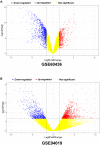SERPINH1, Targeted by miR-29b, Modulated Proliferation and Migration of Human Retinal Endothelial Cells Under High Glucose Conditions
- PMID: 34377003
- PMCID: PMC8350151
- DOI: 10.2147/DMSO.S307771
SERPINH1, Targeted by miR-29b, Modulated Proliferation and Migration of Human Retinal Endothelial Cells Under High Glucose Conditions
Abstract
Aim: In the present study, we performed bioinformatics studies and in vitro functional assays to explore the underlying role of serpin family H member 1 (SERPINH1) in the diabetic retinopathy.
Methods: Common differentially expressed genes (DEGs) between diabetic retinal tissues and normal retinal tissues were analyzed using Gene Expression Omnibus (GEO) database. The proliferation and migration of human retinal endothelial cells (HRECs) was evaluated by MTS, EdU and wound healing assays, respectively; the miRNA and mRNAs expression levels of hub genes in HRECs were determined using quantitative real-time PCR (qRT-PCR). Protein levels were determined using a Western blot assay.
Results: A total of 189 common DEGs were screened between two GEO datasets (GSE60436 and GSE94019), and ten potential hub genes that may link to the progression of diabetic retinopathy were detected. The qRT-PCR results showed that collagen, type I, alpha 1 (COL1A1), Collagen, type I, alpha 2 (COL1A2) and serpin family H member 1 (SERPINH1) mRNA expression levels were up-regulated in the HRECs after being exposed to high glucose for 48 h. Silence of SERPINH1 repressed the high glucose-induced increase in proliferation and migration of HRECs. SERPINH1 was a target of miR-29b and was suppressed by miR-29 in HRECs. SERPINH1 overexpression promoted HREC proliferation and migration. Furthermore, miR-29b suppressed HREC proliferation and migration under high-glucose stimulation, which was significantly attenuated by enforced expression of SERPINH1.
Conclusion: In conclusion, by performing the integrated bioinformatics analysis, the present study suggested that 3 hub genes (COL1A1, COL1A2 and SERPINH1) may be associated with diabetic retinopathy pathophysiology. Further mechanistic studies indicated that miR-29b/SERPINH1 signaling participated in high glucose-induced enhancement in the proliferation and migration of HRECs.
Keywords: HRECs; SERPINH1; bioinformatics analysis; diabetic retinopathy; migration; proliferation.
© 2021 Hu et al.
Conflict of interest statement
The authors report no conflicts of interest in this work.
Figures








Similar articles
-
Upregulation of heparanase in high-glucose-treated endothelial cells promotes endothelial cell migration and proliferation and correlates with Akt and extracellular-signal-regulated kinase phosphorylation.Mol Vis. 2012;18:1684-95. Epub 2012 Jun 20. Mol Vis. 2012. PMID: 22773906 Free PMC article.
-
Integrative analysis of competitive endogenous RNA network reveals the regulatory role of non-coding RNAs in high-glucose-induced human retinal endothelial cells.PeerJ. 2020 Jun 29;8:e9452. doi: 10.7717/peerj.9452. eCollection 2020. PeerJ. 2020. PMID: 32655995 Free PMC article.
-
Ginsenoside Rg1 Inhibits High Glucose-Induced Proliferation, Migration, and Angiogenesis in Retinal Endothelial Cells by Regulating the lncRNA SNHG7/miR-2116-5p/SIRT3 Axis.J Oncol. 2022 Dec 3;2022:6184631. doi: 10.1155/2022/6184631. eCollection 2022. J Oncol. 2022. PMID: 36510610 Free PMC article.
-
Up-regulation of SNHG6 activates SERPINH1 expression by competitive binding to miR-139-5p to promote hepatocellular carcinoma progression.Cell Cycle. 2019 Aug;18(16):1849-1867. doi: 10.1080/15384101.2019.1629772. Epub 2019 Jul 1. Cell Cycle. 2019. PMID: 31258024 Free PMC article.
-
LncRNA XIST promotes extracellular matrix synthesis, proliferation and migration by targeting miR-29b-3p/COL1A1 in human skin fibroblasts after thermal injury.Biol Res. 2019 Sep 20;52(1):52. doi: 10.1186/s40659-019-0260-5. Biol Res. 2019. PMID: 31540582 Free PMC article.
Cited by
-
High-Throughput Sequencing Data Reveal an Antiangiogenic Role of HNF4A-Mediated CACNA1A/VEGFA Axis in Proliferative Diabetic Retinopathy.Invest Ophthalmol Vis Sci. 2023 Jun 1;64(7):32. doi: 10.1167/iovs.64.7.32. Invest Ophthalmol Vis Sci. 2023. PMID: 37342032 Free PMC article.
-
Prognostic analysis of lung adenocarcinoma based on cancer-associated fibroblasts genes using scRNA-sequencing.Aging (Albany NY). 2023 Jul 11;15(14):6774-6797. doi: 10.18632/aging.204838. Epub 2023 Jul 11. Aging (Albany NY). 2023. PMID: 37437244 Free PMC article.
-
Effect of NK-5962 on Gene Expression Profiling of Retina in a Rat Model of Retinitis Pigmentosa.Int J Mol Sci. 2021 Dec 10;22(24):13276. doi: 10.3390/ijms222413276. Int J Mol Sci. 2021. PMID: 34948073 Free PMC article.
-
NR2E3 inhibits the inflammation and apoptosis in diabetic retinopathy by regulating the AHR/IL-17A signaling pathway.Naunyn Schmiedebergs Arch Pharmacol. 2024 Nov;397(11):9081-9094. doi: 10.1007/s00210-024-03213-5. Epub 2024 Jun 17. Naunyn Schmiedebergs Arch Pharmacol. 2024. PMID: 38884674
-
Identification of hub genes and key signaling pathways by weighted gene co-expression network analysis for human aortic stenosis and insufficiency.Front Cardiovasc Med. 2023 Aug 9;10:857578. doi: 10.3389/fcvm.2023.857578. eCollection 2023. Front Cardiovasc Med. 2023. PMID: 37621558 Free PMC article.
References
LinkOut - more resources
Full Text Sources
Miscellaneous

